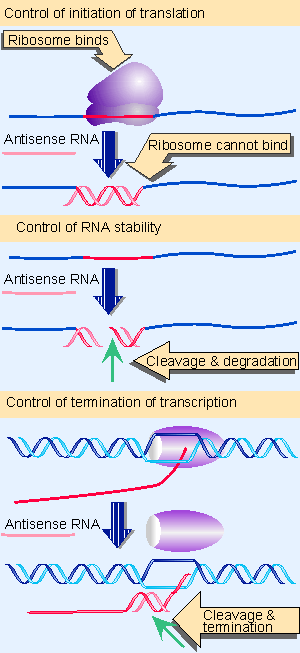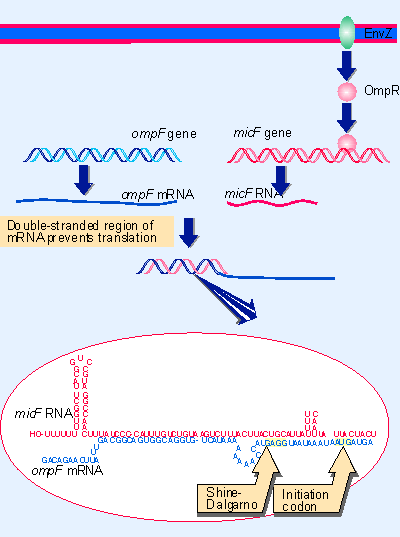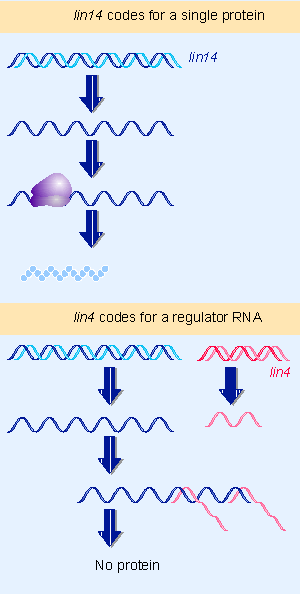14. Small RNA molecules can regulate translation
10.14 Small RNA molecules can regulate translation |
The trans-acting regulators that we have discussed so far are proteins. Yet the formal circuitry of a regulatory network could equally well be constructed by using an RNA as regulator. In fact, the original model for the operon left open the question of whether the regulator might be RNA or protein.
Like a protein regulator, a small regulator RNA is an independently synthesized molecule that diffuses to a target site consisting of a specific nucleotide sequence. The target for a regulator RNA is a single-stranded nucleic acid sequence. The regulator RNA functions by complementarity with its target, at which it can form a double-stranded region.
We can imagine two general mechanisms for the action of a regulator RNA:
- Formation of a duplex region with the target nucleic acid directly prevents its ability to function, by forming or sequestering a specific site.
- Formation of a duplex region in one part of the target molecule changes the conformation of another region, thus indirectly affecting its function.
The feature common to both types of RNA-mediated regulation is that changes in secondary structure of the target control its activity.
A difference between RNA regulators and the proteins that repress operons is that the RNA does not have allosteric properties; it cannot respond to other small molecules by changing its ability to recognize its target. It can be turned on by controlling transcription of its gene or it could be turned off by an enzyme that degrades the RNA regulator product.
 |
Figure 10.45 Antisense RNA can affect function or stability of an RNA target. |
Antisense RNAs are used as regulators in several situations in bacterial cells. Figure 10.45 illustrates three situations. An antisense RNA may bind to an RNA to occlude the site for ribosome binding and thus prevent initiation of protein synthesis. Antisense RNA may also directly destabilize a target mRNA by binding to it to form a duplex region that is the target for an endonuclease. And antisense RNA may affect gene expression by binding to a transcript to mimic a terminator, and thus cause premature termination of transcription. (We discuss some examples of the use of RNA-RNA interactions in specific control systems in other chapters, including control of translation [see 15 Transposons] and replication [see 12 The replicon] (for review see Green et al., 1986).
 |
Figure 10.46 Increase in osmolarity activates EnvZ, which activates OmpR, which induces transcription of micF and ompC (not shown). micF RNA is complementary to the 5 F region of ompF mRNA and prevents its translation. |
The synthesis of a small RNA directly controls translation of the ompF gene of E. coli. The circuit is shown in Figure 10.46. Expression of the unlinked genes ompC and ompF, which code for two of the outer membrane proteins of E. coli, is controlled by the osmolarity of the medium. Increase in osmolarity activates the receptor EnvZ, which in turn activates OmpR, which activates expression of the regulator gene, micF.
The product of micF is an RNA of 174 bases. It is an example of an antisense RNA, which describes any RNA that blocks the function of an mRNA by virtue of complementarity with it.
Synthesis of MicF RNA turns off translation of ompF mRNA. MicF RNA is complementary to a region of OmpF mRNA that includes the ribosome binding site at which translation is initiated. The MicF RNA could therefore function as a regulator by binding to the OmpF mRNA and preventing its translation. It is also possible that formation of a duplex region destabilizes the OmpF mRNA, for example, by making it susceptible to ribonucleases that act on double-stranded regions.
 |
Figure 10.47 lin4 RNA regulates expression of lin14 by binding to the 3 F nontranslated region. |
Figure 10.47 illustrates the behavior of a comparable system in the nematode C. elegans, in which a regulator gene codes for an RNA that is complementary to an mRNA. In this case, the target gene is lin14, which regulates larval development. Expression of lin14 is controlled by lin4, which codes for two small transcripts of 22 and 61 nucleotides, which differ in their termination site. The lin4 transcripts are complementary to a 10 base sequence that is repeated 7 times in the 3′ nontranslated region of lin14. We do not know how binding of the lin4 RNA turns off the expression of lin14; one possibility is that duplex formation prevents export to the cytoplasm, another is that it interferes with translation. This system is especially interesting in implicating the 3′ end as a site for regulation.
Synthesis of antisense RNA can inactivate a target RNA in either prokaryotic or eukaryotic cells. Artificial genes coding for antisense RNAs have been introduced into E. coli, where they prevent expression of the specific target genes to whose mRNAs they are complementary.
 |
Figure 10.48 Antisense RNA can be generated by reversing the orientation of a gene with respect to its promoter, and can anneal with the wild-type transcript to form duplex RNA. |
Antisense genes have been introduced into eukaryotic cells. Such genes are constructed by reversing the orientation of a gene with regard to its promoter, so that the "antisense" strand is transcribed, as illustrated in Figure 10.48. An antisense thymidine kinase gene inhibits synthesis of thymidine kinase from the endogenous gene. Quantitation of the effect is not entirely reliable, but it seems that an excess (perhaps a considerable excess) of the antisense RNA may be necessary (Izant and Weintraub, 1984).
At what level does the antisense RNA inhibit expression? It could in principle prevent transcription of the authentic gene, processing of its RNA product, or translation of the messenger. Results with different systems show that the inhibition depends on formation of RNA PRNA duplex molecules, but this can occur either in the nucleus or in the cytoplasm. In the case of an antisense gene stably carried by a cultured cell, sense-antisense RNA duplexes form in the nucleus, preventing normal processing and/or transport of the sense RNA. In another case, injection of antisense RNA into the cytoplasm inhibits translation by forming duplex RNA in the 5′ region of the mRNA.
This technique offers a powerful approach for turning off genes at will; for example, the function of a regulatory gene can be investigated by introducing an antisense version. An extension of this technique is to place the antisense gene under control of a promoter itself subject to regulation. Then the target gene can be turned off and on by regulating the production of antisense RNA. This technique allows investigation of the importance of the timing of expression of the target gene.
| Reviews | |
| Green, J., Pines, O., and Inouye., M. (1986). The role of antisense RNA in gene regulation. Ann. Rev. Biochem 55, 569-597. | |
| Research | |
| Izant, J. G. and Weintraub, H. (1984). Inhibition of thymidine kinase gene expression by antisense RNA: a molecular approach to genetic analysis. Cell 36, 1007-1015. | |